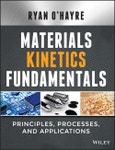Materials Kinetics Fundamentals is an accessible and interesting introduction to kinetics processes, with a focus on materials systems. Designed for the undergraduate student, this book avoids intense mathematics to present the theory and application of kinetics in a clear, reader-friendly way. Students are first introduced to the fundamental concepts of kinetics, with illustrated diagrams, examples, text boxes, and homework questions that impart a unified, intuitive understanding. Further chapters cover the application of these concepts in the context of materials science, with real-world examples including silicon processing and integrated circuit fabrication, thin-film deposition, carbon-14 dating, steel degassing, energy conversion, and more. Instructor materials including a test bank are available through the companion website, providing a complete resource for the undergraduate materials science student.
At its core, kinetics deals with rates, telling us how fast something will take place – for example, how fast water will evaporate, or how fast molten silicon will solidify. This book is designed to provide students with an introduction to kinetics' underlying principles, without rigorous math to distract from understanding.
- Understand universally important kinetic concepts like diffusion and reaction rate
- Model common kinetic processes both quantitatively and qualitatively
- Learn the mechanisms behind important and interesting materials systems
- Examine the behaviors, properties, and interactions of relevant solid materials
There are a large number of books on chemical kinetics, but there are far fewer that focus on materials kinetics, and virtually none that provide an accessible, introductory-level treatment of the subject. Materials Kinetics Fundamentals fills that need, with clear, detailed explanations of these universal concepts.
Table of Contents
Preface xiii
Acknowledgments xv
Learning Objectives xvii
I Kinetic Principles
1 Introduction to Materials Kinetics 3
1.1 What Is Kinetics? 3
1.2 Kinetics Versus Thermodynamics 4
1.3 Homogeneous Versus Heterogeneous Kinetics 6
1.4 Reaction Versus Diffusion 7
1.5 Classifying Kinetic Processes 9
1.6 Brief Word about Units 10
1.7 Chapter Summary 11
1.8 Chapter Exercises 12
2 A Short Detour into Thermodynamics 14
2.1 Dynamic Equilibrium 14
2.2 Enthalpy (H), Entropy (S), and Gibbs Free Energy (G) 15
2.2.1 Relationship between ΔG, ΔH, and ΔS 16
2.3 Molar Quantities 18
2.4 Standard State 19
2.5 Calculating Thermodynamic Quantities 20
2.6 Reaction Quotient Q and Equilibrium Constant K 22
2.7 Temperature Dependence of K 28
2.8 Thermodynamics of Phase Transformations 31
2.9 Ideal Gas Law 34
2.10 Calculating Concentrations for Liquids or Solids 36
2.10.1 Calculating Densities/Concentrations in Pure Materials 36
2.10.2 Calculating Densities/Concentrations in Stoichiometric Compounds or Dilute Solutions 37
2.10.3 Calculating Densities/Concentrations for Mixtures of Multiple Phases/Compounds 39
2.10.4 Calculating Densities/Concentrations from Crystallographic Information 41
2.10.5 Calculating Site Fractions 42
2.11 Chapter Summary 44
2.12 Chapter Exercises 46
3 Chemical Reaction Kinetics 48
3.1 Homogeneous versus Heterogeneous Chemical Reactions 50
3.2 Homogeneous Chemical Reactions 51
3.2.1 Reaction Rate Equation and k 51
3.2.2 Order of Reaction 51
3.2.3 Zero-Order Reactions 53
3.2.4 First-Order Reactions 54
3.2.5 Second-Order Reactions 58
3.2.6 Incomplete Reactions/Equilibrium Reactions 64
3.2.7 Summary of Homogeneous Reaction Kinetics 68
3.3 Temperature Dependence of Reaction Kinetics: Activation Theory 68
3.4 Heterogeneous Chemical Reactions 72
3.4.1 Effect of Catalyst 72
3.4.2 Gas–Solid Surface Reaction Processes 75
3.5 Chapter Summary 79
3.6 Chapter Exercises 81
4 Transport Kinetics (Diffusion) 84
4.1 Flux 85
4.2 Fluxes and Forces 87
4.3 Common Transport Modes (Force/Flux Pairs) 88
4.4 Phenomenological Treatment of Diffusion 90
4.4.1 Steady-State Diffusion: Fick’s First Law 91
4.4.2 Transient Diffusion: Fick’s Second Law 94
4.4.3 Kirkendal Effect and Moving Interface Problems 118
4.4.4 Summary of Transient Diffusion Problems 120
4.4.5 Coupled Diffusion Processes 120
4.5 Atomistic Treatment of Diffusion 125
4.5.1 Overview of Diffusion in Gases Versus Liquids Versus Solids 125
4.5.2 Diffusion in Gases: Kinetic Theory of Gases 126
4.5.3 Diffusion in Solids: Atomistic Mechanisms of Solid-State Diffusion 130
4.5.4 Diffusion in Solids: High-Diffusivity Paths 135
4.6 Chapter Summary 139
4.7 Chapter Exercises 142
II Applications of Materials Kinetics
5 Gas–Solid Kinetic Processes 151
5.1 Adsorption/Desorption 151
5.2 Active Gas Corrosion 157
5.3 Chemical Vapor Deposition 166
5.4 Atomic Layer Deposition 176
5.5 Passive Oxidation 179
5.6 Chapter Summary 184
5.7 Chapter Exercises 187
6 Liquid–Solid and Solid–Solid Phase Transformations 190
6.1 What Is a Phase Transformation? 190
6.2 Driving Forces for Transformation: Temperature and Composition 192
6.2.1 Calculating ΔGV 193
6.3 Spinodal Decomposition: A Continuous Phase Transformation 197
6.4 Surfaces and Interfaces 199
6.4.1 Estimating Surface Energies 200
6.4.2 Interfacial Energy Balances 203
6.4.3 Overview of Important Surface/Interface Energy Effects 205
6.5 Nucleation 205
6.5.1 Homogeneous Nucleation 206
6.5.2 Heterogeneous Nucleation 212
6.5.3 Nucleation Rate 218
6.6 Growth 221
6.7 Nucleation and Growth Combined 226
6.7.1 Effect of Nucleation Rate versus Growth Rate on Microstructure 226
6.7.2 Overall Rate of Transformation: Johnson–Mehl and Avrami Equations 229
6.7.3 Time–Temperature–Transformation Diagrams 230
6.8 Solidification 232
6.8.1 Casting Microstructures 233
6.8.2 Plane Front Solidification (Scheil Equation) 233
6.8.3 Cellular or Dendritic Growth 235
6.8.4 Eutectic Lamellae 237
6.8.5 Peritectic Solidification 240
6.9 Martensitic Transformations 241
6.10 Chapter Summary 242
6.11 Chapter Exercises 247
7 Microstructural Evolution 251
7.1 Capillary Forces 251
7.2 Surface Evolution 256
7.2.1 Surface Evolution by Solid-State Diffusion 256
7.2.2 Surface Evolution by Vapor-Phase Transport 257
7.3 Coarsening 258
7.3.1 Diffusion-Limited Coarsening 258
7.3.2 Source/Sink-Limited Coarsening 259
7.4 Grain Growth 261
7.5 Sintering 263
7.6 Chapter Summary 265
7.7 Chapter Exercises 268
References 270
III Appendixes
A Units 273
B Periodic Table 276
C Answers to Selected Calculation Questions 278
Index 281








